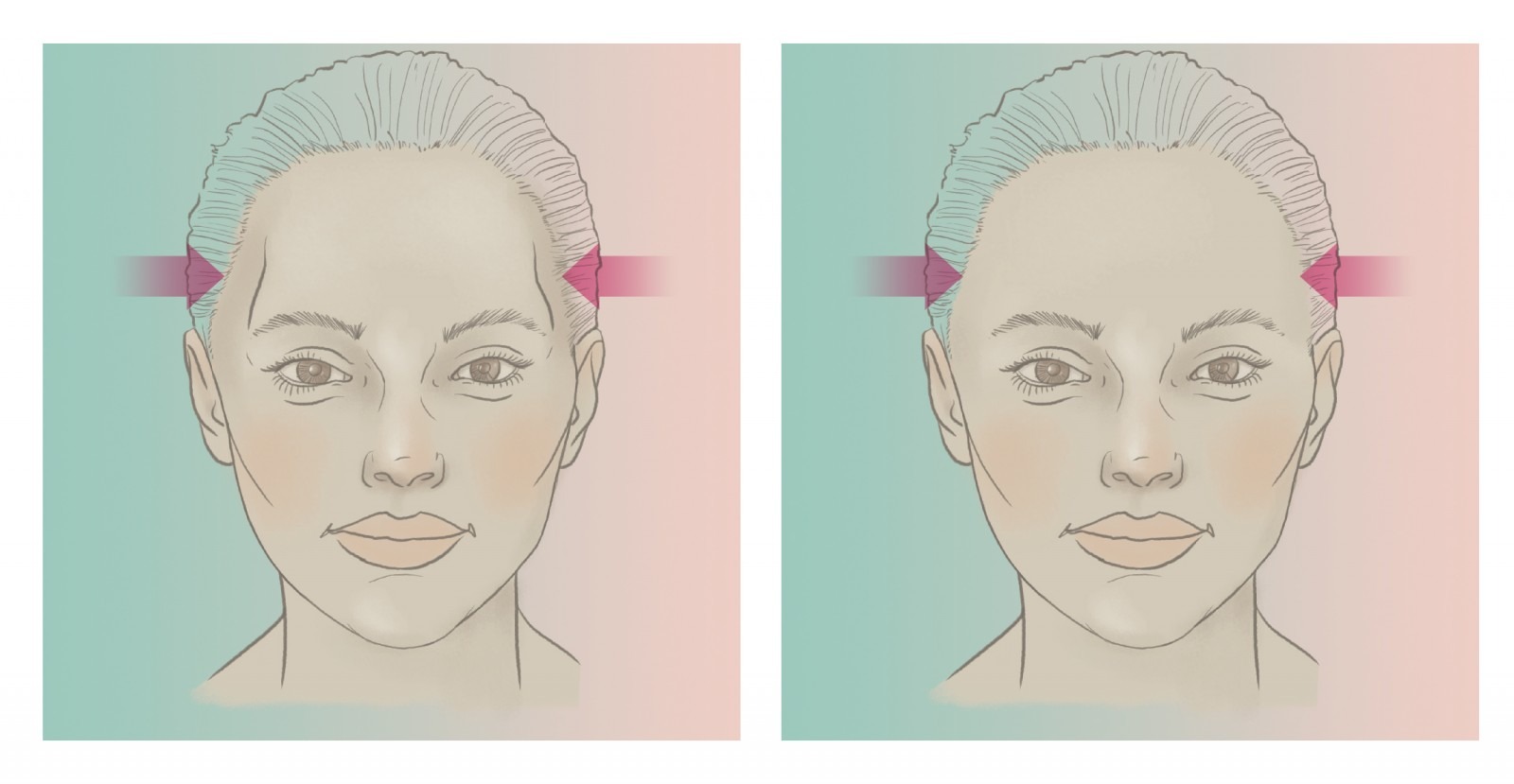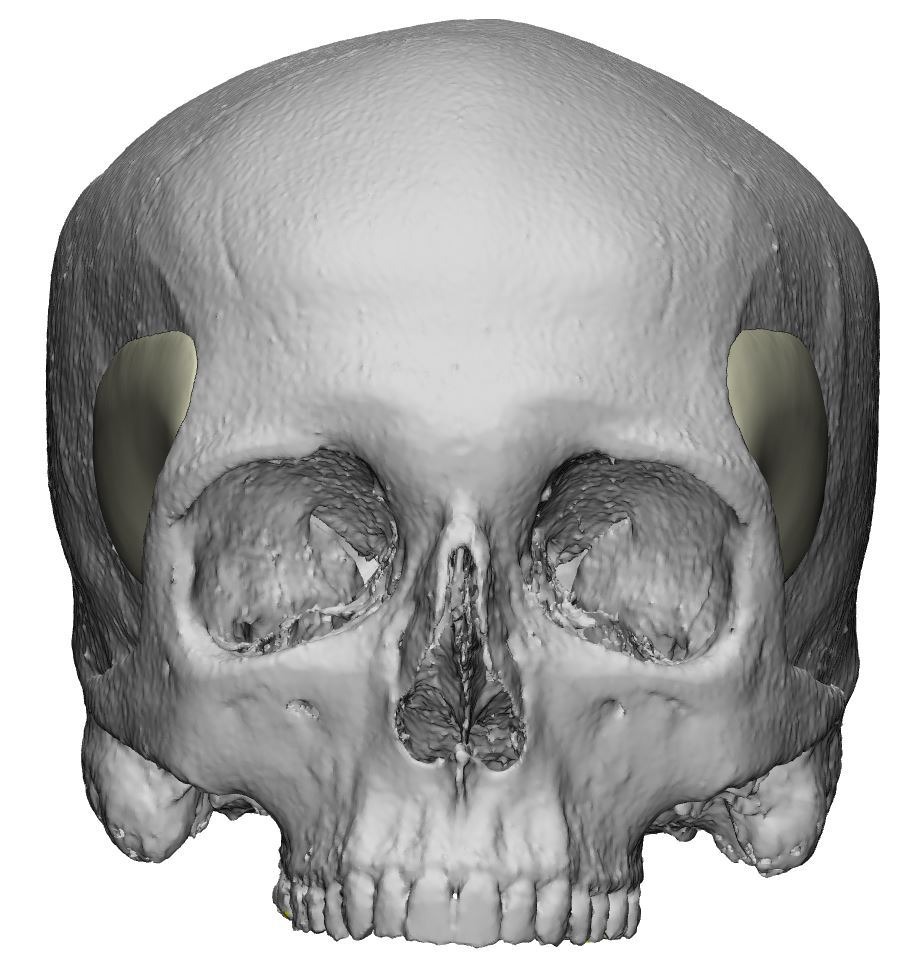Temporal PEEK implants
Table of contents:
How to fill in your temples using custom-made PEEK implants?
Sunken temples give the forehead an hourglass-like, more aged or masculine look. A look considered unattractive by many women. Custom-PEEK implants in the region of the temples can be a good solution to reshape, fill and soften your face contour.

Before and after temporal PEEK implants
What are 'PEEK' implants?
Polyetheretherketone (PEEK) is a synthetic material that was used initially in spine and hip surgery. It has the properties of being:
- biocompatible;
- resistant to thermal and ionizing radiation;
- and biomechanically resembles cortical bone.
These favourable characteristics have led to the increasing use of PEEK implants for calvarial defects, which remain a significant reconstructive challenge, but also in aesthetic surgery.
Where are PEEK implants placed?
Having Custom-made PEEK implants of the temples placed can give the face a more oval feminine look and fill up the hollow temple area. Usually, the placement of the PEEK implants is combined with a forehead recontouring, as the access to the area where the implants need to be placed is already created during forehead recontouring.

Preparing for the procedure
In preparation for the surgery, a CT-scan of the skull needs to be made. For specifications of the CT-scan needed please look here. A proposal for the shape of the implants will be made by Dr van Nimmen in collaboration with the manufacturer of the implants. It will be sent to you by e-mail, so you can see what the implants will look like. After we have received your agreement, the implants will be manufactured.
Procedure
- General anaesthesia — General anaesthesia is usually required for placement of custom- made PEEK implants in the region of the temples.
- Incisions — Usually an incision is made along the hairline. The incision is made just like it would be made during scalp advancement surgery (forehead reduction). If you don’t need a hairline lowering, the so-called "bicoronal" incision made inside the hair is a better option.
- The forehead skin is pulled forward to reveal the bone.
- The temporal muscle is detached from the bone as far as is necessary to insert the implants that are then fixated using Titanium screws.
- The skin will be closed in layers as usual.
Recovery
- Hospital — You will spend one night at the hospital following surgery.
- Pain — Pain may occur for a few days and is manageable with normal painkillers.
- Work — Many patients can go back to work within two weeks following this surgery (as a stand-alone procedure).
- Sport — Avoid physical activity that causes sweating or a rise in blood pressure for eight days.
- Sutures — Sutures are self-dissolving. They dissolve in about a week's time.
- Forehead numbness — Expect your forehead to be numb for about 3 months.
Complications
- Changed feeling of the scalp — Because the skin is detached from the bone during the procedure, it is possible the feeling in the scalp changes. In most of the patients, sensation returns to normal within the year, but some patients report the feeling doesn’t return to normal 100%. Most don’t report this as a problem, but rather as something they noticed.
- In theory, infection of the implants is possible but has so far never occurred. In such a case, antibiotics would be administered. Worst case this doesn’t stop the infection and the implants have to be removed.
Frequently asked questions
What is the cost of facial surgery?
You can find estimated prices here, after your consultation you will be informed of the exact prices of your operation. Prices are average and may vary depending on: the exact treatment or surgery needed; the exact area you want to have treated; your bone structure; your expectations and wishes...
We have a specific procedure to get a quote from the doctor. To receive a personalized quote, please visit the following link to see your different options.
Is there a payment plan or financing option for a surgery?
No, payments have to be made following our payment policy. It is not possible to pay for a surgery via monthly/... payments.
What is the cost of a forehead lift?
You will find all the prices of our treatments and operations here.
How long will the results of a forehead lift last?
A forehead lift has a long-term result of 10 to 15 years. Of course you also have to take into account the natural ageing process of the skin as you get older.
What are the risks of a forehead lift?
Any disadvantages or possible complications can be found here.
Who is a suitable candidate for a forehead lift?
People who suffer from low-set eyebrows, deep frown lines on the forehead and between the eyebrows, drooping eyelids and tension headaches caused by frowning.
How to prepare for a forehead lift?
For this procedure, you do not need to make any specific preparations apart from the standard preoperative instructions. You will receive these by email.
What is the cost of a mid-facelift?
You will find all the prices of our treatments and operations here.
How long will the results of a mid-facelift last?
A mid-facelift is very effective in tightening the skin around the cheeks, and most people are satisfied with the results. The results usually last for about 10 years.
What are the risks of a mid-facelift?
Any disadvantages or possible complications can be found here.
Who is a suitable candidate for a mid-facelift?
A mid-facelift can be a good option for people who want a more youthful appearance, prominent cheekbones and a radiant look, but who do not require surgery to their jawline or forehead.
We are doing our very best to keep this information up-to-date. In case you see anything that no longer seems accurate, or in case you have a question, please fill out the form below.
